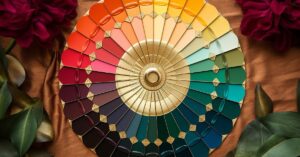The Psychology of Color in Fashion: Understanding Its Impact
January 20, 2021 2024-10-11 10:33The Psychology of Color in Fashion: Understanding Its Impact
Color shapes our world in profound ways, influencing emotions, decisions, and perceptions. In fashion, color becomes a powerful tool that designers and consumers alike use to express identity and mood. At Dhruva College of Fashion Technology, we recognize the importance of understanding color psychology. Let’s explore how color impacts fashion choices and how you can use this knowledge to enhance your style.
1. Introduction to Color Psychology
Color psychology studies how colors affect human emotions and behavior. When it comes to fashion, the colors we choose can evoke feelings, create impressions, and influence how others perceive us. Designers strategically select colors to convey messages and enhance their collections, while consumers choose colors that resonate with their personalities and moods.
2. The Emotional Spectrum of Colors
Different colors evoke various emotions. Here’s a breakdown of some primary colors and their psychological effects:
a) Red: This bold hue symbolizes passion and energy. Wearing red often conveys confidence and authority. Think of a power suit in deep crimson or a striking red dress that draws attention.
b) Blue: A calming color, blue evokes feelings of trust and stability. Fashion designers frequently use blue to create a sense of professionalism. Navy suits and soft blue blouses can project a serene and reliable image.
c) Yellow: Bright and cheerful, yellow represents happiness and optimism. When you wear yellow, you often feel more upbeat and energized. A sunny yellow dress can instantly lift your mood and those around you.
d) Green: Associated with nature and tranquility, green signifies growth and renewal. Fashion in shades of green, from deep emerald to soft sage, can create a sense of balance and harmony. It’s a perfect choice for those who want to convey a peaceful vibe.
e) Black: This classic color exudes elegance and sophistication. Wearing black can create a powerful, sleek image. Think of the little black dress or a tailored black blazer that speaks volumes without saying a word.
f) White: Symbolizing purity and simplicity, white often represents freshness and new beginnings. A crisp white shirt or a flowing white dress can convey a clean, sophisticated look.

3. The Role of Color in Fashion Trends
Fashion trends often shift with the seasons, and color plays a significant role in these changes. Designers carefully choose colors that resonate with the prevailing mood. For instance, bright colors dominate summer collections, while deep, muted tones appear in winter. Understanding these trends allows consumers to stay stylish while aligning their wardrobes with the season’s vibe.
4. Personal Branding Through Color
Your color choices can significantly impact your personal brand. Whether you lean toward vibrant colors or prefer soft, neutral shades, the colors you wear communicate your personality. For example, a creative individual might opt for bold, unexpected colors, while someone in a corporate setting might choose more subdued tones to convey professionalism. By understanding color psychology, you can curate a wardrobe that truly reflects who you are.
5. Cultural Influences on Color Perception
Cultural context plays a significant role in how people perceive colors. For example, while white symbolizes purity and peace in many Western cultures, it often represents mourning in some Eastern cultures. Fashion designers need to be aware of these cultural nuances when selecting colors for their collections to ensure they resonate appropriately with diverse audiences.
6. Tips for Choosing Colors in Fashion
To harness the power of color in your wardrobe, consider these practical tips:
a) Know Your Undertone: Determine whether your skin has warm or cool undertones. Warm undertones often pair well with earthy colors like oranges and yellows, while cool undertones suit blues and greens.
b) Experiment with Combinations: Don’t hesitate to mix and match different colors. Use a color wheel to find complementary hues that create visually appealing combinations.
c) Stay True to Yourself: Choose colors that resonate with your personality. Your wardrobe should be a reflection of who you are and how you want to be perceived.
d) Consider the Occasion: Different events may call for specific color palettes. Bright colors might work for a casual outing, while more muted tones may be appropriate for formal events.
7. The Impact of Fashion Icons on Color Choices
Fashion icons often influence public perception of color in fashion. When a celebrity or designer showcases a particular hue, it can spark trends and shift consumer preferences. For instance, when a high-profile celebrity wears a specific color at an event, it can lead to an increase in that color’s popularity among the general public. Staying aware of these influences can help you adapt your wardrobe to current trends while maintaining your personal style.
8. The Future of Color in Fashion
As sustainability becomes a central theme in fashion, designers are exploring new ways to use color. Eco-friendly dyes and innovative materials will likely change how we perceive and apply color in the industry. Additionally, technology will play a role in this evolution, with advancements allowing for more vibrant, sustainable options. The future of color in fashion will not only focus on aesthetics but also on ethical considerations.

9. Conclusion
The psychology of color significantly impacts fashion choices, influencing how we express ourselves and how others perceive us. At Dhruva College of Fashion Technology, we encourage students to explore the power of color in their designs and personal style. By understanding color psychology, you can enrich your fashion knowledge and enhance your ability to create meaningful connections through style.
FAQs
1. How can I choose the right color for my skin tone?
Determine whether you have warm or cool undertones, then select colors that complement them.
2. Can colors influence my mood?
Absolutely! Different colors can evoke various emotions, affecting how you feel and present yourself.
3. What role does color play in branding?
Color helps communicate a brand’s identity and values, making it crucial for both personal and corporate branding.
4. Are there universal meanings for colors?
While some colors have widely accepted meanings, cultural differences can significantly influence color perceptions.
5. How can I experiment with color in my wardrobe?
Try mixing and matching different colors, and don’t hesitate to step outside your comfort zone!






